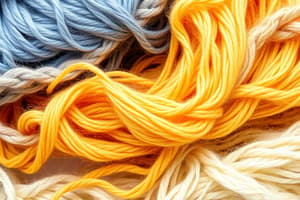Podcast
Questions and Answers
What primarily defines a staple fiber?
What primarily defines a staple fiber?
- Fibers available only in filament form
- Fabrics manufactured by weaving fibers
- Short fibers measured in inches or centimeters (correct)
- Long continuous fibrous structures
Which property determines the overall quality and utility of a fiber?
Which property determines the overall quality and utility of a fiber?
- Cohesiveness
- Elongation
- Moisture absorption
- Fiber length (correct)
What is the minimum length to width ratio (L/W) required for processing fibers?
What is the minimum length to width ratio (L/W) required for processing fibers?
- 1:50
- 1:200
- 1:100 (correct)
- 1:300
Which of the following describes filament fibers?
Which of the following describes filament fibers?
What does fiber flexibility influence in textile manufacturing?
What does fiber flexibility influence in textile manufacturing?
Which primary property affects how consumers select fibers?
Which primary property affects how consumers select fibers?
Which property is least likely to be considered a primary property of fiber?
Which property is least likely to be considered a primary property of fiber?
What range defines the typical length of staple fibers?
What range defines the typical length of staple fibers?
What is the minimum ratio considered essential for processing fibers?
What is the minimum ratio considered essential for processing fibers?
What is the typical unit for measuring tensile strength?
What is the typical unit for measuring tensile strength?
Which fibers are usually shorter than 1.3 cm and seldom used in yarn manufacturing?
Which fibers are usually shorter than 1.3 cm and seldom used in yarn manufacturing?
What characteristic describes fibers with good flexibility?
What characteristic describes fibers with good flexibility?
Why is cohesion less important for filament fibers compared to staple fibers?
Why is cohesion less important for filament fibers compared to staple fibers?
What are the units used to express linear density?
What are the units used to express linear density?
What can be a result of using stiff, inflexible fibers?
What can be a result of using stiff, inflexible fibers?
What is meant by 'tenacity' in the context of fibers?
What is meant by 'tenacity' in the context of fibers?
Flashcards
Textile Fiber
Textile Fiber
The fundamental unit of textiles, long, slender thread-like structures of cells, which are the smallest entities of textiles.
Staple Fiber
Staple Fiber
Short fibers, typically measured in inches or centimeters (2-46 cm), often found in natural fibers, which are cut to a specific length and are not continuous fibers.
Filament Fiber
Filament Fiber
Long, continuous fibers, ranging from hundreds of meters to kilometers in length, and are primarily used for man-made fibers.
Fiber Length
Fiber Length
The average length of a fiber, with a minimum of 5 mm, crucial for fiber quality and utility.
Signup and view all the flashcards
Length to Width Ratio (L/W)
Length to Width Ratio (L/W)
The ratio of fiber length to width, ideally 1:100 or greater for adequate processing, with most fibers exceeding this.
Signup and view all the flashcards
Primary Fiber Properties
Primary Fiber Properties
Essential characteristics of a fiber for manufacturing yarn or fabric, including length, strength, flexibility, cohesiveness, and uniformity, among others.
Signup and view all the flashcards
Secondary Fiber Properties
Secondary Fiber Properties
Characteristics impacting use and end-product features, like thermal, color, recovery properties and the various processing properties of the fiber.
Signup and view all the flashcards
Tensile Strength
Tensile Strength
The maximum stress required to rupture a fiber, measured in units like psi or gf/mm².
Signup and view all the flashcards
Tenacity
Tenacity
Strength per unit linear density, usually expressed as g/d or gf/d.
Signup and view all the flashcards
Linear Density
Linear Density
Mass per unit length of a fiber (e.g., grams per denier or tex).
Signup and view all the flashcards
Denier
Denier
Mass in grams of 9,000 meters of material.
Signup and view all the flashcards
Tex
Tex
Mass in grams of 1,000 meters of material.
Signup and view all the flashcards
Fiber Flexibility
Fiber Flexibility
Ability of a fiber to bend and fold without breaking.
Signup and view all the flashcards
Cohesiveness
Cohesiveness
Property of individual fibers to stick together when spun into yarn.
Signup and view all the flashcards
Fiber Length (Minimum)
Fiber Length (Minimum)
1.3 cm is the minimum length of fibers used in yarn manufacturing.
Signup and view all the flashcards
Processing Ratio (Minimum)
Processing Ratio (Minimum)
A ratio of at least 100 is required for most fibers.
Signup and view all the flashcards
Uniformity (Manufactured Fibers)
Uniformity (Manufactured Fibers)
Virtually identical fibers in a batch.
Signup and view all the flashcards
Uniformity (Natural Fibers)
Uniformity (Natural Fibers)
Natural fibers are not uniform due to growth irregularities.
Signup and view all the flashcardsStudy Notes
Fiber Definition
- Fibers are the fundamental units of textiles.
- They are long, slender thread-like structures of cells.
- They are the smallest entities of textiles.
- They can be spun into yarn or made into fabric.
Staple Fiber
- Short fibers, measured in inches or centimeters.
- Lengths range from 2 to 46 cm.
- All natural fibers are available only in staple form.
- Can be natural or continuous fibers cut to a staple length.
Filament Fiber
- Long continuous fibrous structures.
- Lengths range from a few hundred meters (silk) to several kilometers (man-made fibers).
- Filament thickness is similar to that of fibers.
Fiber Classification
- Fibers are categorized as natural or man-made.
- Natural fibers are further divided into natural vegetable, natural animal, and natural mineral fibers.
- Man-made fibers are divided into regenerated man-made and synthetic man-made fibers, and other man-made fibers.
Primary Fiber Properties
- Length: Average length of the fiber, with a minimum of 5 mm. Determines the overall quality and utility of the fiber, 1.3 cm or less are seldom used in yarn manufacturing.
- Length to Width Ratio (L/W): A ratio of 1:100 is considered essential for processing. Most fibers have significantly higher ratios.
- Strength: Tensile strength, usually expressed as force per unit of linear density. (g/d or gf/mm²).
- Flexibility: Ability of the fiber to bend and fold without breaking. Cellulosic fibers generally have good flexibility; Stiff fibers are difficult to spin into yarn.
Secondary Fiber Properties
- Color
- Recovery: Ability of the fiber to return to its original shape after being stretched.
- Luster: The shine or sheen of the fiber.
- Thermal Properties: (thermal processing)
- Resiliency: Ability of the fiber to resist deformation under stress.
- Elongation: The percentage increase in length of a fiber under stress.
- Abrasion Resistance: Ability of the fiber to resist damage from rubbing.
- Moisture Absorption: Ability of the fiber to absorb moisture.
Fiber Cohesiveness
- Refers to the ability of fibers to stick together. Less important for filament fibers than staple fibers.
Fiber Uniformity
- Allows fibers to be processed more easily. Natural fibers are less uniform than manufactured fibers.
Studying That Suits You
Use AI to generate personalized quizzes and flashcards to suit your learning preferences.




